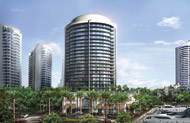|
COVER STORY, JANUARY 2008
SOUTHEAST OUTLOOK 2008
Daniel Beaird
As the commercial real estate industry ends another year and heads into the next, Southeast Real Estate Business continues its tradition of looking back on performances of certain property types in different regions of the Southeast in 2007 and what to expect for those markets in 2008. In this issue, the Gulf Coast retail markets and the Florida multifamily markets are covered. For coverage of the Carolinas office markets, the Georgia industrial markets and the Kentucky and Tennessee industrial markets, please refer to the December 2007 issue of Southeast Real Estate Business.
GULF COAST RETAIL
Maybe to the surprise of some, the Gulf Coast retail market is responding well after Hurricane Katrina ripped through the area more than 2 years ago. Many investors view the Gulf Coast as a land of opportunity and have purchased or expressed interest in purchasing existing centers. However, the challenge for investors is identifying the retail properties for sale as many owners have well performing assets and no desire to sell.
Following Hurricane Katrina, retail development along the Gulf Coast has been focused along the Interstates 10 and 12 corridor, which stretches from Lafayette, Louisiana, to Mobile, Alabama. The retail market has performed well for tenants that have expanded into new developments, particularly in markets with few options outside of a mall. The combination of development and sales signifies healthy growing markets.
New Orleans, in the midst of rebuilding challenges, has witnessed an influx of educated entrepreneurs and professionals that have spurred the retail industry as consumers have spending capacity that they have not had in the past. Smaller markets like Hammond, Louisiana, are attracting retailers as well by expanding retail stores and opening new retail projects.
The suburban market of New Orleans, which experienced far less of the catastrophic damage from Hurricane Katrina, has rebounded significantly. Lowes has recently opened two locations on Jefferson Highway and Elysian Fields Avenue, and Home Depot is opening two new locations, including an Orleans Parish store on Earhart Boulevard at Claiborne Avenue.
“The big box discounters are doing brisk business in stores in or near areas that were mostly unaffected by storm or flood damage, with same store sales in some instances up from 15 to 30 percent more than last year,” says Carol Rockhold Shoemaker of NAI Latter & Blum.
According to NAI Latter & Blum, the major malls on the east bank of Jefferson Parish are back in operation, but not all of the retailers are back. For example, Macy’s has decided not to re-open its downtown store in the closed New Orleans Center, but has recently committed to renovate and re-open its 188,000-square-foot store in The Esplanade Mall in Kenner, Louisiana. Additionally, Macy’s will open a new 228,000-square-foot store at Lakeside Mall in Metairie, Louisiana. Both Macy’s stores are set to come online in November 2008.
Dillards has recently re-opened its store in the 950,000-square-foot Oakwood Center on the Westbank in New Orleans. Also on the Westbank, a new Bed Bath & Beyond and Circuit City are slated for construction on Manhattan Boulevard near the Westbank Expressway. Circuit City also opened a new outlet on Veterans Boulevard in Metairie to replace its recently closed location further west on Veterans Boulevard.
Additionally, the Elmwood Shopping Center on Clearview Parkway is adding a 30,000-square-foot Best Buy and a 17,500-square-foot Old Navy, both of which are build-to-suit projects.
 |
Hammond Square in Hammond, Louisiana
|
|
Some of the other retail projects that have broken ground or are being redeveloped in the Gulf Coast region include Stirling Lafayette Shopping Center in Lafayette, Louisiana; Stirling Millville Shopping Center in Baton Rouge, Louisiana; Hammond Square Mall in Hammond, Louisiana; and Covington Shopping Center in Covington, Louisiana.
“All of the markets in the Gulf Coast have tremendous potential for different reasons,” says Roslyn Pellegrin of Stirling Properties. “We are seeing redevelopment and development opportunities in New Orleans, Gulfport/Biloxi, Baton Rouge, Lafayette and along the north shore from Slidell to Hammond. These are all growth markets and should continue to see a mix of new development and redevelopment opportunities going forward.”
FLORIDA MULTIFAMILY
Florida’s multifamily market is still trying to recover from the condominium conversion craze that crashed a few years ago. The craze left a number of condominiums empty and ready to be re-converted back into rental product. The fallout has had an effect on Florida’s entire economy as businesses that were directly related to the home-building industry have either down sized or closed their doors completely, causing the office and industrial markets to take a hit in Florida.
However, with the subprime credit crisis taking its effect on residential real estate, more people are returning to rental side of town. Homebuyers that were extended credit for first home mortgages a few years ago are not afforded that luxury today as lenders begin to correct the market. These former homeowners are renters once again in the multifamily market, actually helping to boost the multifamily market somewhat.
As the market tries to recover, cost of land and construction, both astronomical only 1 year ago, are beginning to slightly lower in price. Florida’s state economy has a large impact on the Southeast’s economy as a whole. So, Florida will be watched closely in 2008 to see if it recovers heading into 2009. And the first market to be watched will be the market that originally over extended itself, Florida’s multifamily market.
South Florida
The reduction of condominium conversions is redefining the multifamily market in South Florida. In the short term, an excess of housing stock, mostly consisting of recently built for-sale units or failed condominium conversions, is increasingly weighing on upper-tier rentals in South Florida.
In Broward and Palm Beach counties, the performance of Class B/C rentals continues to withstand supply-side pressures. In Broward, for example, the Miramar, Pembroke Pines, Davie, Plantation and Coral Springs submarkets, where more than half of the rental stock consists of Class A units, have only posted a mild increase in asking rents during this year. In Palm Beach, asking and effective rents have actually declined thus far this year in Boynton Beach, a submarket in which more than half of rental units are Class A.
The number of transactions continues to decline due to the absence of conversion buyers and tighter mortgage financing. According to Marcus & Millichap, though, well-maintained Class B/C properties underwritten with moderate rent growth assumptions may be increasingly viewed as solid values in the months ahead.
In Miami-Dade County, apartment vacancy is approximately 4 percent. However, in primary waterfront submarkets such as Bal Harbour, North Miami Beach, Miami Beach and South Beach, the vacancy rate is greater than the market wide level. The market is set to deliver 19,000 condominiums this year and in 2008. According to Marcus & Millichap, that significant number of condominium units will most likely come online not as vacation rentals, but as rental apartments and vacation rentals that will be in competition with lodging properties. However, even all of those units were rental properties, they would not replace the 24,000 rental units lost to conversion in recent years.
 |
Bellini in Aventura, Florida
|
|
Developers are still active in condominium projects in the South Florida area. For example, South Florida developer Martin Margulies is building Bellini, a 24-story condominium project on Williams Island in Aventura, Florida. Construction is scheduled to begin in the first quarter of 2008 and be completed by the end of 2009.
Prices are still climbing in the South Florida multifamily market, but not at the rate they were climbing during the condominium conversion boom. In months ahead, the properties with proven track records as rentals will continue to price at the low end of the range.
Tampa
A slower rate of employment growth has been lowering demand for multifamily rentals in Tampa. Apartment demand, however, may be bolstered in the near term as a rising number of foreclosures forces some homeowners into rental housing. But, the Tampa apartment sector continues to respond to a slower pace of expansion in the local economy. Vacancy and rent growth will be affected by demand-side factors instead of the conversion-related supply reductions that helped drive vacancy lower and spurred rent hikes.
According to Marcus & Millichap, properties with assumable financing are likely to dominate investment market activity in Tampa in the months ahead. Owners and investors should expect should ups and downs in the market as activity and prices revert to a more normal and sustainable level.
Orlando
Just like the other Florida markets, Orlando witness a number of condominium conversions, and supply and demand are still being realigned. As for supply, completions of multifamily rentals are expected to decline in 2007 from 2006. An excess of housing supply consisting of single-family homes and failed condominium conversions, however, is a greater supply-side issue in the near term. Over the long term, demand arising from continued population growth will ease the imbalance of supply and restore the apartment market to a normal level.
In the investment arena, according to Marcus & Millichap, a return to a conventional level of activity is also occurring. In the months ahead, all-cash deals or transactions with assumable financing will price Orlando’s cap rates at the lower end of the range. Higher quality properties will also command low cap rates, while cap rates for lesser quality assets will rise gradually.
Overall, the multifamily market in Florida has taken a hit. The bust of the condominium conversion craze has led to a number of deals being left on the market as properties are trading a much slower pace than that of a few years ago. A significant amount of multifamily product that was planned is now being developed as part of mixed-use projects.
“We expect sellers’ expectations to become more in line with buyers’ expectations,” says Greg Matus, regional manager in Marcus & Millichap’s Orlando, Florida, office. “We also believe that cap rates for all investment properties will increase slightly. Also, expect vacancy rates to increase in the first half of 2008 and then moderate during the second half of the year.”
©2008 France Publications, Inc. Duplication
or reproduction of this article not permitted without authorization
from France Publications, Inc. For information on reprints
of this article contact Barbara
Sherer at (630) 554-6054.
|
